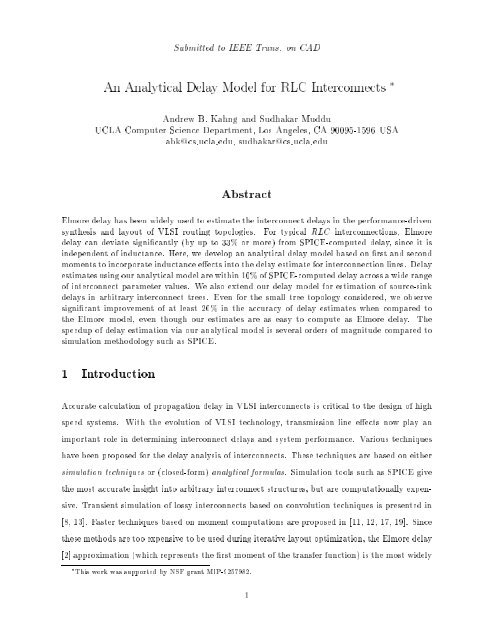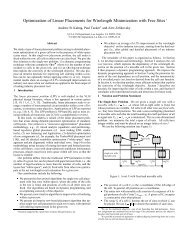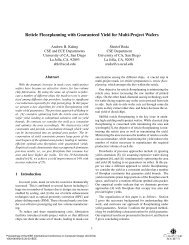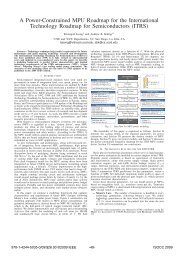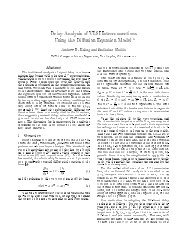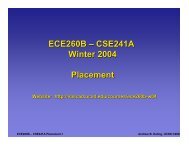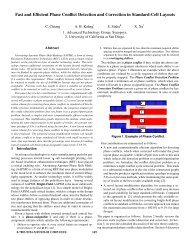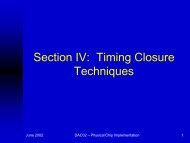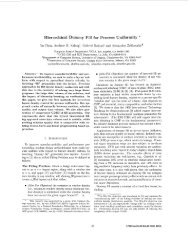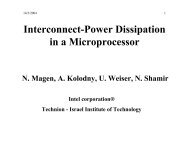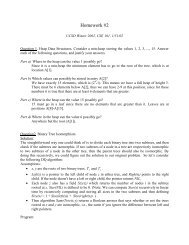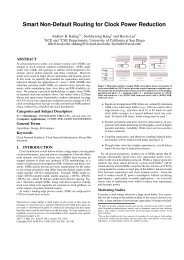An Analytical Delay Model for RLC Interconnects - UCSD VLSI CAD ...
An Analytical Delay Model for RLC Interconnects - UCSD VLSI CAD ...
An Analytical Delay Model for RLC Interconnects - UCSD VLSI CAD ...
You also want an ePaper? Increase the reach of your titles
YUMPU automatically turns print PDFs into web optimized ePapers that Google loves.
Submitted to IEEE Trans. on <strong>CAD</strong><br />
<strong>An</strong> <strong>An</strong>alytical <strong>Delay</strong> <strong>Model</strong> <strong>for</strong> <strong>RLC</strong> <strong>Interconnects</strong> <br />
<strong>An</strong>drew B. Kahng and Sudhakar Muddu<br />
UCLA Computer Science Department, Los <strong>An</strong>geles, CA 90095-1596 USA<br />
abk@cs.ucla.edu, sudhakar@cs.ucla.edu<br />
Abstract<br />
Elmore delay has been widely used to estimate the interconnect delays in the per<strong>for</strong>mance-driven<br />
synthesis and layout of <strong>VLSI</strong> routing topologies. For typical <strong>RLC</strong> interconnections, Elmore<br />
delay can deviate signicantly (by up to 33% or more) from SPICE-computed delay, since it is<br />
independent of inductance. Here, we develop an analytical delay model based on rst and second<br />
moments to incorporate inductance eects into the delay estimate <strong>for</strong> interconnection lines. <strong>Delay</strong><br />
estimates using our analytical model are within 10% of SPICE-computed delay across a wide range<br />
of interconnect parameter values. We also extend our delay model <strong>for</strong> estimation of source-sink<br />
delays in arbitrary interconnect trees. Even <strong>for</strong> the small tree topology considered, we observe<br />
signicant improvement of at least 20% in the accuracy of delay estimates when compared to<br />
the Elmore model, even though our estimates are as easy to compute as Elmore delay. The<br />
speedup of delay estimation via our analytical model is several orders of magnitude compared to<br />
simulation methodology such as SPICE.<br />
1 Introduction<br />
Accurate calculation of propagation delay in <strong>VLSI</strong> interconnects is critical to the design of high<br />
speed systems. With the evolution of <strong>VLSI</strong> technology, transmission line eects now play an<br />
important role in determining interconnect delays and system per<strong>for</strong>mance. Various techniques<br />
have been proposed <strong>for</strong> the delay analysis of interconnects. These techniques are based on either<br />
simulation techniques or (closed-<strong>for</strong>m) analytical <strong>for</strong>mulas. Simulation tools such as SPICE give<br />
the most accurate insight into arbitrary interconnect structures, but are computationally expensive.<br />
Transient simulation of lossy interconnects based on convolution techniques is presented in<br />
[8, 13]. Faster techniques based on moment computations are proposed in [11, 12,17,19]. Since<br />
these methods are too expensive to be used during iterative layout optimization, the Elmore delay<br />
[2] approximation (which represents the rst moment of the transfer function) is the most widely<br />
This work was supported by NSF grant MIP-9257982.<br />
1
*** DO NOT PROPAGATE this draft or in<strong>for</strong>mation contained within ***<br />
used delay model in the per<strong>for</strong>mance-driven design of clock distribution and Steiner global routing<br />
topologies. However, Elmore delay cannot accurately estimate the delay <strong>for</strong> <strong>RLC</strong> interconnect<br />
lines, i.e., the representation <strong>for</strong> interconnects whose inductive impedance 1 cannot be neglected<br />
[4]. To see the eect of inductance impedance on the response, consider a 2-port model <strong>for</strong> an<br />
interconnect driven by a step input with nite source impedance. Figure 1 compares the RC and<br />
<strong>RLC</strong> line responses computed by SPICE3e: 90% threshold delay is288ps <strong>for</strong> the <strong>RLC</strong> model,<br />
but is 358 ps <strong>for</strong> the RC model. Elmore delay, which does not depend on line inductance, will<br />
yield the same delay estimate of 386 ps <strong>for</strong> both the RC and the <strong>RLC</strong> cases. More generally, the<br />
Elmore delay <strong>for</strong>mula gives good estimates if the interconnect lines are RC or overdamped, but<br />
gives overestimates <strong>for</strong> <strong>RLC</strong> or underdamped interconnects. This inaccuracy can be harmful <strong>for</strong><br />
current per<strong>for</strong>mance-driven routing methods which try to optimize interconnect segment lengths<br />
and widths (as well as drivers and buers).<br />
<strong>RLC</strong> <strong>Model</strong><br />
RC <strong>Model</strong><br />
Figure 1: Comparison of SPICE3e responses at the end of an interconnect line driven by a<br />
step input and terminated with a capacitive load using both RC and <strong>RLC</strong> 2-port models.<br />
The 90% threshold delay <strong>for</strong> the <strong>RLC</strong> modelis288ps, and <strong>for</strong> the RC model the delay is<br />
358 ps. The driver resistance is 10:0 and the load capacitance at the end of the line is 2:0<br />
pF . The interconnect line parameters are R =0:075 =m, L =0:123 pH=m, C =8:8<br />
fF=m; the length of the line is 400 m.<br />
This paper gives a new and accurate analytical delay estimate <strong>for</strong> distributed <strong>RLC</strong> interconnects<br />
which considers the eect of inductance. Previous moment-based approaches (e.g.,<br />
1 Inductive impedance is 2fL, wheref is the frequency of operation.<br />
2
*** DO NOT PROPAGATE this draft or in<strong>for</strong>mation contained within ***<br />
[9, 11,8]) can compute a delay estimate only from a simulated response but not from an analytical<br />
<strong>for</strong>mula. To experimentally validate our analysis and delay <strong>for</strong>mula, we model <strong>VLSI</strong><br />
interconnect lines having various combinations of source and load parameters, and obtain delay<br />
estimates from SPICE, Elmore delay and the proposed analytical delay model. The delay estimate<br />
using SPICE is extracted from a computed response at the desired node, whereas the other<br />
two models are analytical (closed-<strong>for</strong>m) expressions. Over our range of test cases, Elmore delay<br />
estimates can be as much as 50% from the SPICE-computed delays, while our analytical delay<br />
model estimates are within 15% of SPICE delays. We also extend our delay model to estimate<br />
source-sink delays in arbitrary interconnect trees. For the small tree topology considered, delay<br />
estimates using our analytical model are within 15% of SPICE-computed delays. While Elmore<br />
delay estimates vary by asmuch as 35% from the SPICE-computed delays. Since our analytical<br />
model has the same time complexity as the Elmore model, we believe that it can be useful in<br />
present-day per<strong>for</strong>mance-driven routing methodologies.<br />
The organization of our paper is as follows. In Section 2 we discuss previous analytical delay<br />
models <strong>for</strong> distributed interconnect lines. Section 3 presents a new analytical delay model model<br />
<strong>for</strong> a distributed <strong>RLC</strong> line, and nally Section 4 extends our delay model <strong>for</strong> interconnection<br />
trees.<br />
2 Previous <strong>An</strong>alytic <strong>Delay</strong> <strong>Model</strong>s<br />
The transfer function of an <strong>RLC</strong> interconnect line with source and load impedance (Figure 2)<br />
can be obtained using the ABCD parameters [1] as<br />
H(s) = V 2(s)<br />
V 0 (s) = 1<br />
h i cosh(h)+<br />
Z S<br />
Z 0<br />
sinh(h) + 1<br />
Z T<br />
where = p (r + sl)sc is the propagation constant andZ 0 =<br />
impedance; r = R h ;l = L h ;c = C h<br />
[Z 0 sinh(h)+Z S cosh(h)]<br />
q<br />
R+sL<br />
sC<br />
(1)<br />
is the characteristic<br />
are resistance, inductance, and capacitance per unit length<br />
and h is the length of the line. To compute the <strong>RLC</strong> line response from the transfer function, the<br />
method of Pade approximation has been used by, e.g., [9, 10]. The output transfer function is<br />
expanded into a Maclaurin series of s around s = 0, and the series is truncated to desired order. 2<br />
2 The work of [8] used a recursive convolution based approach and expanded the admittance and the propagation<br />
coecient term around s = 1.<br />
3
*** DO NOT PROPAGATE this draft or in<strong>for</strong>mation contained within ***<br />
In general, analytical computation of the exact voltage response is very tedious and is usually in<br />
the <strong>for</strong>m of an innite series.<br />
ZS<br />
Distributed <strong>RLC</strong> line<br />
v (t) i (t)<br />
v (t) i (t)<br />
0 0 1 1<br />
i (t) v (t)<br />
2 2<br />
Z T<br />
Figure 2: 2-port model of a distributed <strong>RLC</strong> line with source impedance Z S<br />
impedance Z T .<br />
and load<br />
Ecient delay estimates <strong>for</strong> RC lines are typically derived by considering a single interconnect<br />
line with resistive source and capacitive load impedances; delay <strong>for</strong>mulas <strong>for</strong> an interconnect tree<br />
entail recursive application of the <strong>for</strong>mula <strong>for</strong> a single line. The analytical Elmore delay [2]<br />
estimate, Sakurai's heuristical delay <strong>for</strong>mula [15, 16] and single pole delay estimates of [3] have<br />
been widely used.<br />
Elmore delay is dened to be the rst moment of the system impulse response, i.e., the<br />
coecient ofs or the rst moment in the system transfer function H(s). Applying this<br />
denition to H(s) in Equation (1) and considering a source resistance R S and a capacitive<br />
load C T , the Elmore delay <strong>for</strong> a distributed RC or <strong>RLC</strong> line model is<br />
T ED = R S (C + C T )+R( C 2 + C T ) (2)<br />
By considering only one pole in the transfer function, i.e, approximating the denominator<br />
polynomial to only rst moment, the single pole response can be obtained as in [3]. The<br />
single pole of the transfer function is equal to the inverse of the Elmore delay T ED . Hence,<br />
the delay at arbitrary thresholds of the single pole response can be directly related to Elmore<br />
delay (Elmore delay actually corresponds to the 63:2% threshold voltage of the single pole<br />
response). For example, delay at 90% threshold voltage is<br />
T 0:9 = 2:3 T ED =1:15RC +2:3(R S (C + C T )+RC T ) (3)<br />
Sakurai [15] alsogave response and delay calculations <strong>for</strong> the distributed RC line. He calculates<br />
the time-domain response from the transfer function using the Heaviside expansion<br />
4
*** DO NOT PROPAGATE this draft or in<strong>for</strong>mation contained within ***<br />
over poles of the transfer function. Then, he approximates the response using a single pole<br />
and observes the variation of delay with respect to source and load parameters; a 90%<br />
threshold delay estimate is heuristically obtained as<br />
T 0:9 (h) =1:02RC +2:3(R S (C + C T )+RC T )<br />
Note that Sakurai's heuristic delay <strong>for</strong>mula is almost identical to the Elmore delay equation (3).<br />
In this paper, to compute the 90% threshold delay according to the Elmore model we apply<br />
Equation (3). Since these single pole delay estimates cannot accurately estimate delay <strong>for</strong> <strong>RLC</strong><br />
interconnects, Zhou et al. [19] proposedatwo-pole approximation <strong>for</strong> the transfer function to<br />
compute the response at the load <strong>for</strong> <strong>RLC</strong> interconnection trees. However, this technique is<br />
based on response computation and does not provide any analytical expression <strong>for</strong> delay; it is too<br />
time-consuming to be used in iterative optimization of layout. Recently, [7] proposed to improve<br />
the Elmore delay model by using higher-order moments; this work gave a heuristic net delay<br />
model equal to the sum of the rst moment (M 1 ) and its standard deviation. 3<br />
3 A New <strong>An</strong>alytical <strong>Delay</strong> <strong>Model</strong><br />
We nowdevelop a simple closed-<strong>for</strong>m delay estimate, based on rst and second moments, which<br />
considers the eect of inductance.<br />
To our knowledge, this is the rst analytical delay model<br />
which handles arbitrary threshold voltages and inductance eects <strong>for</strong> a distributed line. We give<br />
experimental conrmation via 90% threshold delay estimates 4 which we compare against SPICE<br />
output. 5<br />
We model an arbitrary interconnect line as follows: (i) the source is modeled as a resistive<br />
and inductive impedance (Z S = R S + sL s ), and (ii) the load at the end of the interconnect line<br />
is modeled using capacitive impedance. Thus, the transfer function <strong>for</strong> the interconnect line of<br />
p 3 Standard deviation is equal to = jM1 2 , M2j. In the early drafts of our paper [6] we also considered exactly<br />
the same model; however, it turns out that this model is not accurate <strong>for</strong> various source and load parameters, as<br />
discussed in detail by [6]. The full version of our paper [6] studies various combinations of rst and second moments,<br />
of which the analytical model described here per<strong>for</strong>ms best.<br />
4 Our analytical model extends to any threshold delays; we simply give the derivation <strong>for</strong> 90% delay threshold.<br />
5 SPICE simulation results are obtained using SPICE3 and the built-in LTRA (lossy transmission line) model,<br />
which is based on convolution techniques [13].<br />
5
*** DO NOT PROPAGATE this draft or in<strong>for</strong>mation contained within ***<br />
S<br />
R<br />
S<br />
L<br />
S<br />
A B T<br />
Distributed <strong>RLC</strong> line<br />
v (t) i (t) v (t) i (t)<br />
0 0 1 1<br />
i (t)<br />
2 v 2<br />
(t)<br />
C T<br />
Figure 3: 2-port model of a distributed <strong>RLC</strong> line with resistive and inductive source<br />
impedance, and capacitive load impedance.<br />
Figure 3 is<br />
H(s) =<br />
where Z T = 1<br />
sC T<br />
, Z S = R S + sL S , Z 0 =<br />
cosh(h) 1+ Z S<br />
Z T<br />
<br />
+ sinh(h)<br />
<br />
ZS<br />
Z 0<br />
+ Z 0<br />
q<br />
R+sL<br />
sC<br />
1<br />
Z T<br />
<br />
and h = p (R + sL)sC. We truncate this<br />
transfer function by expanding the hyperbolic functions around s = 0; expansion around s = 1<br />
is not necessary since we consider only the rst few coecients of the transfer function. I.e.,<br />
expanding cosh and sinh as innite series and collecting terms up to the coecient ofs 2 in the<br />
denominator, we obtain the truncated transfer function<br />
H(s) <br />
1<br />
1+sb 1 + s 2 b 2<br />
with coecients<br />
b 1 = R S C + R I C T + RC 2 + RC T<br />
b 2 = R SRC 2<br />
6<br />
+ R SRCC T<br />
2<br />
+ (RC)2<br />
24<br />
+ R2 CC T<br />
6<br />
+ L S C + L S C T + LC 2 + LC T (4)<br />
Note that the rst and second moments of the transfer function can be obtained from the coef-<br />
cients b 1 and b 2 , i.e., M 1 = b 1 and M 2 = b 2 , b 1 2.We use the coecient notation b 1 ;b 2 and the<br />
moment notation M 1 ;M 2 interchangeably according to the simplicity of the expression. Depending<br />
on the sign of b 2 , 4b 1 2, the poles of the transfer function can be either real or complex. We<br />
separately derive our delay model from the two-pole response <strong>for</strong> each of these cases.<br />
Real Poles:<br />
The two-pole methodology [6, 19] yields the following response <strong>for</strong> the case of real poles:<br />
v(t) =V 0 (1 , s 2<br />
s 2 , s 1<br />
e s 1t + s 1<br />
s 2 , s 1<br />
e s 2t )<br />
6
*** DO NOT PROPAGATE this draft or in<strong>for</strong>mation contained within ***<br />
Source Load <strong>Delay</strong> from <strong>An</strong>alytical <strong>Delay</strong><br />
Response <strong>Model</strong>s<br />
R S L S C T SPICE Elmore New <strong>Model</strong><br />
pH pF ps ps ps<br />
50 2.46 0.176 22.33 22.93 22.21<br />
100 2.46 0.176 45.30 45.20 45.70<br />
500 2.46 0.176 224.50 223.50 228.95<br />
1000 2.46 0.176 446.20 446.4 457.46<br />
25 2.46 1.76 107.10 108.40 108.65<br />
50 2.46 1.76 210.10 210.80 214.74<br />
100 2.46 1.76 415.20 415.40 425.10<br />
500 2.46 1.76 2052.60 2053.0 2103.68<br />
1000 2.46 1.76 4099.50 4100.0 4101.30<br />
Table 1: 90% threshold voltage delay estimates <strong>for</strong> combinations of source and load parameters<br />
<strong>for</strong> which the poles of the response are real (i.e., overdamped response). The interconnect<br />
line parameters are R =0:015 =m, L =0:246 pH=m and C =0:176 fF=m and the<br />
length of the interconnect is 100 m.<br />
where<br />
s 1;2 =<br />
,M 1 <br />
2<br />
q<br />
4M 2 , 3M 2 1<br />
q<br />
= ,b 1 b 2 , 4b 1 2<br />
2b 2<br />
The condition <strong>for</strong> the poles to be real is (4M 2 , 3M 2 1<br />
)=(b 2 1<br />
, 4b 2 ) 0. Since s 2 , s 1 = ,<br />
is negative, the coecients<br />
s 2<br />
s 2 ,s 1<br />
and s 1<br />
s 2 ,s 1<br />
p<br />
b 2 1 ,4b 2<br />
b 2<br />
are positive. Also, since the magnitude js 2 j is greater<br />
than js 1 j, the second term in the time-domain response decreases rapidly compared to the rst<br />
term. Hence, the two-pole response can be approximated (lower-bounded) as<br />
v(t) V 0 (1 , s 2<br />
s 2 , s 1<br />
e s 1t )<br />
Since the voltage is lower-bounded, the delay obtained is an upper bound on the actual delay. The<br />
delay r (the subscript indicates the case of real poles) at threshold voltage v th can be obtained<br />
via<br />
Letting K r =ln<br />
<br />
(s2 , s 1 )(1 , v th )<br />
s 1 r =ln<br />
<br />
s 2<br />
1<br />
[1 + p<br />
b 1<br />
2(1,v th )<br />
b 2 1 ,4b 2<br />
r = K r<br />
js 1 j = K M 1 +<br />
r<br />
<br />
<br />
] ,wehave<br />
0<br />
= , ln @<br />
1<br />
2(1 , v th ) [1 + b<br />
q<br />
1<br />
]<br />
b 2 , 4b 1 2<br />
q<br />
4M 2 , 3M 2 1<br />
2<br />
q<br />
2b 2<br />
= K r<br />
b 1 , b 2 , 4b 1 2<br />
1<br />
A<br />
7
*** DO NOT PROPAGATE this draft or in<strong>for</strong>mation contained within ***<br />
i.e., K r is a function of the coecients b 1 and b 2 . For the wide range of source, load and<br />
interconnect parameter values considered in our simulations (see Table 1), we nd that K r<br />
actually almost a constant: the plot on the left side of Figure 4 shows the linear regression used<br />
to nd the value K r =2:36 which givesavery strong t between SPICE delay values and 1<br />
js 1 j .<br />
The variation of K r with the quantity X = b 2<br />
b 2 1<br />
r =2:36 <br />
b 1 ,<br />
2b<br />
q 2<br />
b 2 , 4b 1 2<br />
is further discussed in [6]. Thus, we use<br />
=2:36 (M 1 +<br />
q<br />
4M 2 , 3M 2)<br />
1<br />
; (5)<br />
2<br />
the resulting delay estimates are compared against those of various other methods in Table 1.<br />
We see that our analytical delay model gives estimates close to those obtained from SPICE, but<br />
as expected Elmore delay also gives good estimates <strong>for</strong> this case where the interconnect response<br />
is overdamped.<br />
is<br />
500<br />
10<br />
450<br />
9<br />
400<br />
8<br />
SPICE <strong>Delay</strong> (ps)<br />
350<br />
300<br />
250<br />
200<br />
150<br />
SPICE <strong>Delay</strong> (ps)<br />
7<br />
6<br />
5<br />
4<br />
3<br />
100<br />
2<br />
50<br />
0<br />
0 20 40 60 80 100 120 140 160 180 200<br />
1/s1<br />
1<br />
0<br />
0 1 2 3 4 5 6<br />
1/β<br />
Figure 4: The plot on the left shows the strong linear t between SPICE delay and 1<br />
js 1 j<br />
<strong>for</strong><br />
real poles with K r =2:36. The plot on the right shows the strong linear t between SPICE<br />
delay and 1 <strong>for</strong> complex poles with K c =1:66.<br />
Complex Poles<br />
The condition <strong>for</strong> complex poles is (4M 2 , 3M 2 1 )=(b2 1 , 4b 2) 0. The time-domain response<br />
<strong>for</strong> complex poles is given by<br />
p !<br />
2 + <br />
v(t) =V 0 1 ,<br />
2<br />
e ,t sin(t + )<br />
<br />
p<br />
M<br />
where = 1<br />
3M<br />
=<br />
2(M<br />
1 2 1 2 ,4M 2<br />
and = tan ,1 ( ). Using the above equation and threshold<br />
,M 2) 2(M<br />
1 2 ,M 2) <br />
8
*** DO NOT PROPAGATE this draft or in<strong>for</strong>mation contained within ***<br />
voltage v th ,weget<br />
e ,t sin( t + ) =<br />
1 , v th<br />
q<br />
1+(<br />
<br />
)2 (6)<br />
The delay atagiven threshold voltage can be computed by solving <strong>for</strong> time in Equation (6)<br />
recursively. One way to solve the recursive Equation (6) is to approximate the time variable in<br />
the exponential term by Elmore delay, i.e., substitute T ED <strong>for</strong> time t. Expanding sine as a Taylor<br />
series and considering only the rst term yields<br />
There<strong>for</strong>e,<br />
where K c =<br />
e ,T ED<br />
sin( c + ) e ,T ED<br />
( c + ) =<br />
c = K c<br />
<br />
1 , v th<br />
q<br />
1+(<br />
<br />
)2<br />
<br />
<br />
(1,v th )e T ED<br />
, . Substituting <strong>for</strong> and using M p1+( 1 = b 1 and M 2 = b 2 , b<br />
)2 1 2, our<br />
delay estimate is given by<br />
c = K c<br />
<br />
= K 2b 2<br />
c q<br />
4b 2 , b 2 1<br />
Even though K c is function of b 1 and b 2 , <strong>for</strong> a wide range of interconnect, source, and load<br />
parameters it too is almost a constant. We determined the constant value K c =1:66 again by<br />
nding a good t between SPICE delay values and 1 ,asshown on the right side of Figure 4.<br />
<br />
There<strong>for</strong>e, the 90% threshold delay estimate <strong>for</strong> complex poles is<br />
c =1:66 q<br />
2b 2<br />
2(M<br />
=1:66 1<br />
, M 2 )<br />
q<br />
4b 2 , b 2 1<br />
3M 2 , 4M 1 2<br />
: (7)<br />
Table 2 shows delay values <strong>for</strong> various combinations of source, load and interconnect parameters<br />
assuming the value of K c obtained by this regression analysis. The delay estimates using<br />
our analytical model are within 10% of SPICE-computed delay estimates, while Elmore delay<br />
estimates vary by asmuch as 33% from SPICE-computed delays. Hence, <strong>for</strong> the case of complex<br />
poles (i.e., underdamped response), the Elmore model is no longer acceptably accurate. Last, we<br />
consider the special case in which poles are equal, i.e., a double pole conguration.<br />
Double Poles<br />
The condition <strong>for</strong> a double pole is (b 2 1<br />
, 4b 2 ) = 0. The double-pole response is<br />
V (s) = V 0<br />
s<br />
1<br />
1+b 1 s + b 2 s = V 0<br />
2 s<br />
1<br />
b 2 (s , s 1 ) 2 = V 0<br />
9<br />
1<br />
s , 1<br />
s , s 1<br />
, 2 b 1<br />
1<br />
(s , s 1 ) 2
*** DO NOT PROPAGATE this draft or in<strong>for</strong>mation contained within ***<br />
Source Load <strong>Delay</strong> from <strong>An</strong>alytical <strong>Delay</strong><br />
Response <strong>Model</strong>s (% error)<br />
R S L S C T SPICE Elmore New <strong>Model</strong><br />
pH pF ps ps ps<br />
10 0.0246 0.0176 1.22 0.90 (26%) 1.30 (6%)<br />
15 0.0246 0.0176 1.33 1.31 ( 2%) 1.38 ( 4%)<br />
20 0.0246 0.0176 1.47 1.71 ( 16%) 1.51 ( 3%)<br />
25 0.0246 0.0176 1.60 2.12 ( 33%) 1.64 ( 3%)<br />
10 0.0246 0.176 4.50 5.12 ( 14%) 4.25 ( 6%)<br />
15 0.0246 0.176 5.85 7.32 ( 25%) 5.31 ( 9%)<br />
20 0.0246 0.176 7.90 9.55 (21 %) 8.60 ( 7%)<br />
10 2.46 0.0176 1.31 0.90 ( 31%) 1.40 ( %)<br />
15 2.46 0.0176 1.40 1.31 ( 7%) 1.49 ( 7%)<br />
20 2.46 0.0176 1.55 1.71 ( 10%) 1.59 ( 2%)<br />
25 2.46 0.0176 1.63 2.12 ( 30%) 1.69 ( 4%)<br />
10 2.46 0.176 4.65 5.10 ( 10%) 4.30 ( 8%)<br />
15 2.46 0.176 5.85 7.33 ( 25%) 5.30 ( 9%)<br />
20 2.46 0.176 7.98 9.55 ( 19%) 8.70 ( 9%)<br />
10 24.6 0.0176 1.80 0.90 ( 50%) 1.96 ( 9%)<br />
15 24.6 0.0176 1.89 1.31 ( 31%) 2.06 ( 9%)<br />
20 24.6 0.0176 2.00 1.71 ( 15%) 2.15 ( 7%)<br />
25 24.6 0.0176 2.19 2.11 ( 4%) 2.21 ( 1%)<br />
10 24.6 0.176 5.65 5.10 ( 10%) 5.44 ( 4%)<br />
15 24.6 0.176 6.50 7.33 ( 13%) 5.95 ( 8%)<br />
20 24.6 0.176 7.66 9.55 ( 25%) 6.97 ( 9%)<br />
25 24.6 0.176 9.47 11.78 ( 24%) 9.26 ( 2%)<br />
Table 2: 90% threshold voltage delay estimates <strong>for</strong> the combinations of source and load parameters<br />
<strong>for</strong> which the poles of the response are complex (i.e., underdamped congurations).<br />
The interconnect line parameters are R =0:015 =m, L =0:246 pH=m and C =0:176<br />
fF=m and the length of the interconnect is 100 m. The percentage error of each delay<br />
model with respect to SPICE is also given.<br />
where s 1 = , b 1<br />
2b 2<br />
, and the time-domain response is given by v(t) =V 0<br />
<br />
1 , e<br />
ts 1<br />
, 2t<br />
b 1<br />
e ts 1<br />
. The<br />
delay at 90% threshold is<br />
0:9 = 2b 2<br />
b 1<br />
which gives a recursive equation <strong>for</strong> K d , i.e.,<br />
K d =ln<br />
<br />
ln 10(1 + 2T <br />
0:9 2b 2 b 1<br />
) = K d = K d<br />
b 1 b 1 2<br />
<br />
10(1 + 2T 0:9<br />
b 1<br />
<br />
=ln(10(1 + K d ))<br />
10
*** DO NOT PROPAGATE this draft or in<strong>for</strong>mation contained within ***<br />
from which K d 3:9. Thus, in the case of a double pole the 90% threshold delay is estimated as<br />
0:9 = K d b 1<br />
2 =1:95b 1 (8)<br />
which is independent of the inductance value and dierent from the Elmore delay expression.<br />
I3<br />
N4<br />
I2<br />
N3<br />
I4<br />
N5<br />
I6<br />
N7<br />
N1<br />
I1<br />
N2<br />
I5<br />
N6<br />
I7<br />
N8<br />
I8<br />
N9<br />
Figure 5: A simple interconnection tree consisting of distributed <strong>RLC</strong> lines. The lengths<br />
of the various interconnects are given in Table 3.<br />
4 Interconnection Trees<br />
Finally, wenow describe the extension of our analytical model to estimate delays in arbitrary<br />
interconnect trees. <strong>An</strong> <strong>RLC</strong> network is called an <strong>RLC</strong> tree if it does not contain a closed path<br />
of resistors and inductors, i.e., all resistors and inductors are oating with respect to ground and<br />
all capacitors are connected to ground. Consider an <strong>RLC</strong> interconnect tree with root (or source)<br />
S and set of sinks (or leafs) L = fL 1 ;L 2 ;:::;L n g. The unique path from root S to the sink node<br />
i is denoted by p(i) and is referred as the main path. The edges/nodes not on the main path are<br />
referred as the o-path edges/nodes. We model each edge on the main path of the tree using a<br />
lumped <strong>RLC</strong> segment, e.g., an L, T, or model. We replace the o-path subtree rooted at node<br />
k with the total subtree capacitance at node k. (Figure 6 shows an example of a main path where<br />
each branch in the tree is replaced by <strong>RLC</strong> segments, and the o-path subtrees are replaced by<br />
their respective subtree capacitances.) Hence, at any nodek the total capacitance is given by<br />
11
*** DO NOT PROPAGATE this draft or in<strong>for</strong>mation contained within ***<br />
Interconnect<br />
Length<br />
m<br />
I1 50<br />
I2 100<br />
I3 50<br />
I4 200<br />
I5 100<br />
I6 50<br />
I7 100<br />
I8 200<br />
Table 3: The length of various interconnects in the tree of Figure 5.<br />
C 0 k<br />
= C k if no o-path subtree at node k<br />
= C k + C T (k) if node K has o-path subtree T (k)<br />
where C k is the capacitance at the node and C T (k) is the o-path subtree capacitance at node<br />
k. The k th coecient b k of the transfer function <strong>for</strong> the general <strong>RLC</strong> circuit of Figure 6 can be<br />
expressed using the following recursive equation [5]:<br />
b N +1<br />
k<br />
= R N<br />
N X<br />
j=1<br />
C 0 j b j k,1 + L N<br />
NX<br />
j=1<br />
C 0 j b j k,2 + bN k (9)<br />
where b N K refers to the coecient ofsk in the transfer function between node k and node 1. Note<br />
that b j 0 =1,bj ,1 =0<strong>for</strong>allj and b1 k<br />
= 0 <strong>for</strong> all k. Using the above recursive equation the<br />
expressions <strong>for</strong> the rst and second coecients of the transfer function can be derived as<br />
b N +1<br />
1<br />
= R N<br />
N X<br />
j=1<br />
C 0 j + b N 1<br />
=<br />
b N +1<br />
2<br />
= R N<br />
N X<br />
j=1<br />
C 0 jb j 1 + L N<br />
=<br />
NX<br />
NX<br />
X<br />
NX<br />
i=1<br />
NX<br />
j=1<br />
X<br />
j,1 j,1<br />
C 0 j<br />
R l C 0 j<br />
j=2 l=j i=1 d=i<br />
R i<br />
iX<br />
j=1<br />
C 0 j + b N 2<br />
R d +<br />
C 0 j<br />
NX<br />
NX<br />
C 0 j<br />
j=1 l=j<br />
L l (10)<br />
For any given source and sink pair the coecients b 1 and b 2 can be computed in linear time<br />
by traversing the main path and using the above recursive equation. Using the analytical delay<br />
model developed in the previous section, we can obtain a analytical delay estimate <strong>for</strong> <strong>RLC</strong><br />
12
*** DO NOT PROPAGATE this draft or in<strong>for</strong>mation contained within ***<br />
R S<br />
V R L V R L<br />
V V R L<br />
N+1<br />
N N N N-1 N-1 N-1<br />
2 1 1<br />
S<br />
C’ C’ C’<br />
V<br />
1<br />
T<br />
N N-1<br />
1<br />
C T<br />
Figure 6: Representation of the main path in the tree, where each distributed line is modeled<br />
using <strong>RLC</strong> segments.<br />
interconnect trees using the rst and second coecients. Thus, the 90% threshold delay ata<br />
given sink i, depending on the value of (4M 2 , 3M 2 1<br />
), is<br />
p<br />
= K r (M 1+ 4M 2 ,3M1 2 )<br />
<strong>for</strong> Real poles<br />
2<br />
2(M<br />
T ND (i)<br />
1<br />
= K c <br />
2 ,M 2)<br />
<strong>for</strong> Complex poles<br />
p<br />
3M 2 1 ,4M 2<br />
= K d M 1<br />
2<br />
<strong>for</strong> Double poles<br />
(11)<br />
where the rst and second moments are expressed as M 1 = b 1 and M 2 = b 2 , b 1 2. The coecients<br />
of the transfer function are obtained from Equation (10). By contrast, the Elmore delay at<br />
the sink is equal to the rst moment, or the rst coecient b 1 of the transfer function of the<br />
source-sink main path [14]. The 90% threshold delay using the rst moment is simply<br />
T ED (i) =2:3 M 1 (12)<br />
which we emphasize can be inaccurate despite its wide use, since it ignores inductance of the<br />
interconnect line.<br />
We evaluate the eect of our analytical model by considering a simple interconnection tree<br />
shown in Figure 5. We consider the sink node N4 <strong>for</strong> delay estimation. Each edge on the main<br />
path between the root and node N4 is replaced by atwo L segment model. 6<br />
We then apply<br />
the above described recursive coecient (or moment) computation <strong>for</strong> the resultant <strong>RLC</strong> circuit<br />
of the main path. The 90% threshold delays according to both the Elmore model and our new<br />
analytical model are computed using Equations (11) and (12). We also compute the delay at<br />
the given sink node using SPICE3e, where each edge of the tree is modeled using the LTRA<br />
6 Our model is not limited to traditional segment models, and indeed we believe the accuracy of our results<br />
would improve ifwe use non-uni<strong>for</strong>m segment models [5, 18] designed to perfectly match the low-order moments<br />
of the distributed <strong>RLC</strong> line.<br />
13
*** DO NOT PROPAGATE this draft or in<strong>for</strong>mation contained within ***<br />
Interconnect Driver Load SPICE Elmore New <strong>Model</strong><br />
parameters res. cap. <strong>Delay</strong> <strong>Delay</strong> <strong>Delay</strong><br />
/m pF ps ps ps<br />
R =0:015 <br />
C =0:176 fF 10 0.02 5.7 6.6 5.0<br />
L =0:246 pH<br />
R =0:0015 <br />
C =0:176 fF 10 0.2 37 26 31<br />
L =2:46 pH<br />
R =0:015 <br />
C =0:176 fF 10 0.2 39 29 32<br />
L =2:46 pH<br />
R =0:0015 <br />
C =0:176 fF 10 2.0 179 238 205<br />
L =2:46 pH<br />
R =0:0015 <br />
C =0:176 fF 10 2.0 231 238 232<br />
L =0:246 pH<br />
R =0:015 <br />
C =0:176 fF 10 2.0 199 270 230<br />
L =2:46 pH<br />
R =0:015 <br />
C =0:176 fF 100 2.0 2419 2361 2367<br />
L =2:46 pH<br />
Table 4: 90% threshold delay values <strong>for</strong> a wide range of interconnect parameters at Node<br />
4 of the tree in Figure 5. We compare SPICE LTRA, and the Elmore model, against our<br />
analytical delay model.<br />
(Lossy Transmission Line) model (with SPICE, we rst compute the response at the sink node<br />
and then obtain the delay <strong>for</strong> 90% threshold voltage). Table 4 presents delay estimates <strong>for</strong> a<br />
range of interconnect parameters, driver resistance values, and sink load capacitance values. The<br />
Elmore delay varies by asmuch as 35% from the SPICE-computed delay. However, our new<br />
model is within 15% of the SPICE delay <strong>for</strong> all examples. <strong>An</strong>other advantages of our model<br />
is due to simulation complexity.<br />
Our delay estimates also require three orders of magnitude<br />
less computation than SPICE, since they have the same time complexity as the Elmore delay<br />
estimate.<br />
14
*** DO NOT PROPAGATE this draft or in<strong>for</strong>mation contained within ***<br />
5 Conclusions<br />
Fast delay estimation methods, as opposed to simulation techniques, are needed <strong>for</strong> incremental<br />
per<strong>for</strong>mance-driven layout synthesis. Elmore delay based estimation methods, although ecient,<br />
cannot accurately estimate the delay <strong>for</strong><strong>RLC</strong> interconnect lines. We have obtained an analytical<br />
delay model, based on rst and second moments of <strong>RLC</strong> interconnection lines, which considers<br />
the eect of inductance. Resulting delay estimates are signicantly more accurate than Elmore<br />
delay. We also extend our delay model to estimate source-sink delays in arbitrary interconnect<br />
trees. Even <strong>for</strong> the small tree topology considered, we observe signicant improvement ofatleast<br />
20% in the accuracy of our delay estimates, compared to the Elmore model. Since our model has<br />
the same time complexity as the Elmore model, we believe it can be valuable in modern iterative<br />
layout synthesis methodologies. Our ongoing work applies our analytical model to delay-driven<br />
routing tree construction, zero-skew routing, and delay estimation in nets spanning multiple<br />
routing layers (i.e., with modeling of vias).<br />
15
References<br />
[1] L. N. Dworsky, Modern Transmission Line Theory and Applications, Wiley, 1979.<br />
[2] W. C. Elmore, \The Transient Response of Damped Linear Networks with Particular Regard to<br />
Wideband Ampliers", Journal of Applied Physics 19, Jan. 1948, pp. 55-63.<br />
[3] M. A. Horowitz, \Timing <strong>Model</strong>s <strong>for</strong> MOS Circuits", PhD Thesis, Stan<strong>for</strong>d University, Jan. 1984.<br />
[4] C. C. Huang and L. L. Wu, \Signal Degradation Through Module Pins in <strong>VLSI</strong> Packaging", IBM<br />
J. Res. and Dev. 31(4), July 1987, pp. 489-498.<br />
[5] A. B. Kahng and S. Muddu, \Two-pole <strong>An</strong>alysis of Interconnection Trees", Proc. IEEE MCMC<br />
Conf., January 1995, pp. 105-110.<br />
[6] A. B. Kahng and S. Muddu, \Accurate <strong>An</strong>alytical <strong>Delay</strong> <strong>Model</strong>s <strong>for</strong> <strong>VLSI</strong> Interconnections", UCLA<br />
CS Dept. TR-950034, Sep. 1995.<br />
[7] B. Krauter, R. Gupta, J. Willis, and L. T. Pileggi, \Transmission Line Synthesis", Proc. 32th<br />
ACM/IEEE Design Automation Conf., June 1995, pp. 358-363.<br />
[8] S. Lin and E. S. Kuh, \Transient Simulation of Lossy Interconnect", Proc. 29th ACM/IEEE Design<br />
Automation Conf., June 1992, pp. 81-86.<br />
[9] S. P. McCormick and J. Allen, \ Wave<strong>for</strong>m Moment Methods <strong>for</strong> Improved Interconnection <strong>An</strong>alysis",<br />
Proc. 27th ACM/IEEE Design Automation Conf., June 1990, pp. 406-412.<br />
[10] L. T. Pillage and R. A. Rohrer, \Asymptotic Wave<strong>for</strong>m Evaluation <strong>for</strong> Timing <strong>An</strong>alysis", IEEE<br />
Trans. on <strong>CAD</strong> 9, Apr. 1990, pp.352-366.<br />
[11] V. Raghavan, J. E. Bracken and R. A. Rohrer, \AWESpice: A General Tool <strong>for</strong> the Accurate and<br />
Ecient Simulation of Interconnect Problems", Proc. 29th ACM/IEEE Design Automation Conf.,<br />
June 1992, pp. 87-92.<br />
[12] C. L. Ratzla, N. Gopal, and L. T. Pillage, \RICE: Rapid Interconnect Circuit Evaluator", Proc.<br />
28th ACM/IEEE Design Automation Conf., June 1991, pp. 555-560.<br />
[13] J. S. Roychowdhury and D. O. Pederson, \Ecient Transient Simulation of Lossy Interconnect",<br />
Proc. 28th ACM/IEEE Design Automation Conf., June 1991, pp. 740-745.<br />
[14] J. Rubinstein, P. Peneld and M. A. Horowitz, \Signal <strong>Delay</strong> inRCTree Networks", IEEE Trans.<br />
on <strong>CAD</strong> 2(3), July 1983, pp. 202-211.<br />
[15] T. Sakurai, \Approximation of Wiring <strong>Delay</strong> in MOSFET LSI", IEEE Journal of Solid-State Circuits,<br />
Aug. 1983, Vol.18, No.4, pp. 418-426.<br />
[16] T. Sakurai, \Closed-Form Expressions <strong>for</strong> Interconnection <strong>Delay</strong>, Coupling, and Crosstalk in<br />
<strong>VLSI</strong>'s", IEEE Trans. on Electron Devices 40, Jan. 1993, pp. 118-124.<br />
[17] M. Sriram and S. M. Kang, \Fast Approximation of The Transient Response of Lossy Transmission<br />
Line Trees", Proc. ACM/IEEE Design Automation Conf., June 1993, pp. 691-696.<br />
[18] Q. Yu and E. S. Kuh, \Exact Moment Matching <strong>Model</strong> of Transmission Lines and Application to<br />
Interconnect <strong>Delay</strong> Estimation", IEEE Trans. <strong>VLSI</strong> Systems 3, June 1995, pp. 311-322.<br />
[19] D. Zhou, S. Su, F. Tsui, D. S. Gao and J. S. Cong, \A Simplied Synthesis of Transmission Lines<br />
with A Tree Structure", Intl. Journal of <strong>An</strong>alog Integrated Circuits and Signal Processing 5, Jan.<br />
1994, pp. 19-30.


